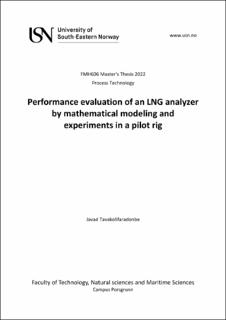| dc.description.abstract | Moreld Flux is in process of designing and manufacturing a sampling instrument for collecting liquified natural gas (LNG) and sending the sample for further analysis. Therefore, this project is defined to perform a literature study on sampling techniques from process streams, evaluating different equations of states (EoS) and developing procedures to calculate the bubble points, and finally assemble a pilot rig and performed some experiments to validate the developed model on the vaporizer part of the sampling instrument.
In this regard, firstly a comprehensive definition of representative sampling and the condition and benefits of an acceptable representative sample is provided. In the following, an extended literature study is performed on the five most popular sampling techniques in industries, including grab sampling techniques, Adsorption Techniques, Cryogenic techniques, Trapping techniques, Dipping techniques, and tube sampling. For each technique advantages and disadvantages are investigated and examples of their applicability of them are also provided.
This study enlists the four most popular EoS, namely van der Waals, RK, SRK, and PR, and develops a thermodynamic model to calculate the compressibility factor (Z) for pure components. Then, a scientifically defined open-source package in python (Phasepy) is applied to develop the models for calculating the phase equilibrium and bubble point of multicomponent mixtures. This study shows that Phasepy can be a reliable package for computing phase equilibria. For this purpose, four binary mixtures (Benzene + Cyclohexane, Benzene + Chlorobenzene, Cyclohexane + Chlorobenzene) and two four-components LNG mixtures are modeled using Phasepy. For comparing the modeling outputs and experimental results, average absolute relative deviation (AARD) and absolute maximum deviation (AMD) are calculated. AMD and AARD for all mixtures are always less than 0.05 (mole fraction) and 3% respectively.
In the case of experimenting, although the facilities have not been provided, based on the literature studied and some standards a sampling procedure for collecting accurate data is prepared. The under-study vaporizer should be equipped with three thermocouples and a Coriolis flow meter is to be used to measure temperatures and flow rate respectively. In this way, a LabVIEW program is provided for real-time measuring temperatures and flow rates using National Instrument modules, including NI 9207 and NI 9211. In addition, simulation on the vaporizer shows that for the flow rate of 2 kg/hr, the outlet temperature of fluid would not be more than 250 K for LN2, whereas the Coriolis flowmeter can work in higher temperatures. Therefore, a post-heating part should also be added to the rig. Based on the immersed helically coiled tube into a bath, this study develops a model for calculating the required tube length based on heat exchanger inlet temperature, heat exchanger outlet temperature, bath temperature, tube dimensions, and physical properties of a fluid. | |
